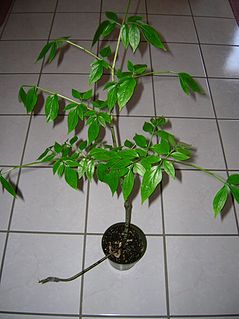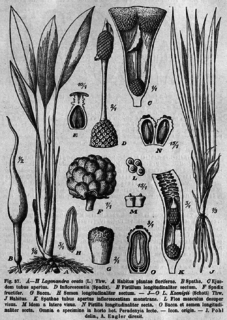
The Araceae are a family of monocotyledonous flowering plants in which flowers are borne on a type of inflorescence called a spadix. The spadix is usually accompanied by, and sometimes partially enclosed in, a spathe or leaf-like bract. Also known as the arum family, members are often colloquially known as aroids. This family of 114 genera and about 3750 known species is most diverse in the New World tropics, although also distributed in the Old World tropics and northern temperate regions.

Cryptocoryne is a genus of aquatic plants from the family Araceae. The genus is naturally distributed in tropical regions of India, Southeast Asia and New Guinea.

Anubias is a genus of aquatic and semi-aquatic flowering plants in the family Araceae, native to tropical central and western Africa. They primarily grow in rivers and streams, but can also be found in marshes. They are characterized by broad, thick, dark leaves that come in many different forms. The genus was revised in 1979 and since then its nomenclature has been stable. Species can be determined by using mostly characteristics of the inflorescence. Because of the often shady places where the plants grow, the genus was named after the Egyptian god Anubis, the god of the afterlife. The genus was first described in 1857 by Heinrich Wilhelm Schott, with A. afzelii as its type species.

Gonatopus is a genus of flowering plants in the family Araceae, consisting of about five species. This genus is native to eastern and southeastern Africa and is closely related to the genus Zamioculcas. The plant generally only produces one leaf from its tuber when in growth. In G. boivinii, the leaf is tripinnate, and with its stalk can reach up to 1 m in height and 40 cm broad; the individual leaflets are up to 10 cm long and 3.5 cm broad; in G. angustus, the leaf can reach 1.5 m tall. A spadix flower arises from the tuber during late spring.

Barclaya is a genus of 3 - 4 species of flowering plants of the family Nymphaeaceae. Barclaya are aquatic plants native to tropical Asia. The genus was named in honour of the American-born English brewer and patron of science Robert Barclay.

Cryptocoryne beckettii, also known as Beckett's water trumpet, is a plant species belonging to the Araceae genus Cryptocoryne.
Cryptocoryne affinis is a plant species belonging to the Araceae genus Cryptocoryne.
Cryptocoryne undulata, also known as undulate cryptocoryne, is a plant species belonging to the Araceae genus Cryptocoryne.

Cryptocoryne × willisii is a plant in the family Araceae.

Cryptocoryne wendtii, the Wendt's water trumpet, is a species of herb which is a popular aquarium plant which is native to Sri Lanka. It was described by Dutch botanist Hendrik de Wit in honour of aquarium hobbyist and writer Albert Wendt.
Cryptocoryne auriculata is a plant species belonging to the Araceae genus Cryptocoryne.

Lagenandra is a genus of flowering plants in the family Araceae. It is endemic to the Indian Subcontinent. The genus is similar to Cryptocoryne, but can be distinguished from it by its involute vernation. Cryptocoryne on the other hand exhibit convolute vernation.
Hendrik (Henk) Cornelis Dirk de Wit was a Dutch systematic botanist who contributed significantly to the knowledge of the Aroid genera Cryptocoryne and Lagenandra. He grew up in the Waterland, a marshy area in the Northwest Netherlands, and had a lifelong interest in aquatic plants.

Heinrich (Harry) Wilhelm Eduard van Bruggen was a Dutch amateur botanist.

Anubias afzelii is a species belonging to the Aroid genus Anubias. It was first described scientifically by Heinrich Wilhelm Schott in 1857, based on material collected in Sierra Leone by Adam Afzelius, after whom the species was named. The genus Anubias was described simultaneously, with only A. afzellii belonging to it, which therefore is the type species of the genus. No other species currently placed in the genus Anubias was described earlier and A. afzelii was therefore the first species of this genus known to science.

Anubias heterophylla is a species belonging to the Aroid genus Anubias. It was first described scientifically by Adolf Engler in 1879.

Aponogeton capuronii is an aquatic plant found in southeastern Madagascar.
Anubias gigantea is a species belonging to the Aroid genus Anubias. It was first mentioned by Auguste Chevalier in 1920, based on material that he had collected in Guinea. The formal description followed in 1939 by John Hutchinson. It is closely related to A. afzelii, basically only differing from that species by the form of the leaf-blade.

Anubias hastifolia is a species belonging to the Aroid genus Anubias. It was first mentioned by Adolf Engler in 1889 and described scientifically by him in 1893.
Cryptocoryne usteriana is a species of aquatic herb in the family Araceae endemic to the Philippines. It was named after the German botanist Alfred Usteri who discovered the plant in the island-province of Guimaras in 1902. The species can also be found in the mainland Panay, in tributaries of lowland bedrock river with not too rapidly flowing water and seasonal flood pools. During the summer, its natural habitat dries up and plants undergo complete meltdown. The following monsoon rain and inundation triggers the remaining rootstock or rhizome to regrow quickly and send blooms underwater. Due to overcollection for the aquarium trade, the local government categorized it as threatened species.













